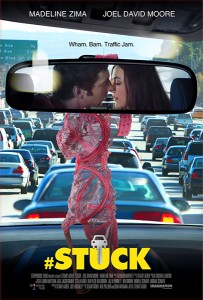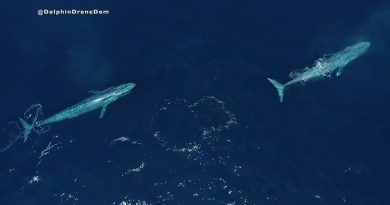Stuart Acher: Carmageddon unsticks #STUCK
I interviewed Award-Winning Independent Filmmaker Stuart Acher about breaking in, Roger Ebert, Carmageddon, and his latest film #STUCK. Here’s what he had to say.
Cat Doss: When did you realize you wanted to be a filmmaker?

(Photo provided by Stuart Acher)
Stuart Acher: When I was 12 my Stepdad dusted off an old Beta-Max camera from the garage — full of junk — handed it to me and said, “want this?”
That was it. I began messing around with it, and when I was in 6th grade, it all came to fruition. I had an English project on “What you wanted to be when you grow up,” and we had to give an oral presentation in front of the class.
I was terrified so I asked if I can make a movie instead. After the initial “that-sort-of-defeats-the-purpose-of-an-oral-presentation” back and forths, she agreed — for double my grade.
I always worked well under pressure. So, the irony is, I made a movie about being a doctor. My grandfather was going through open-heart surgery at the time and I was fascinated. So we got a mannequin, and a cow’s heart, and scrubs, and I made a film interviewing “the doctor” (Me wearing a mask) during open-heart surgery. I got an A. The rest was history.
CD: That’s adorable! Did you watch a lot of movies growing up?
SA: Religiously. Movies are how I learned about everything. Especially girls … until I actually interacted with them in real life, at which point I realized how real life experience is a heck of a lot more educational.
CD: Are there any films that you feel have strongly influenced your work?
SA: Back to the Future is my go to. Filmmakers always throw out some obtuse or artsy or old film to sound cool and educated in the language of film, but frankly — there were so many times I wished I had that damn time traveling DeLorean — that has to count for something. Not to mention the film is perfect.

(Photo via Wikipedia)
CD: I heard you had a pretty interesting encounter with Roger Ebert at Sundance a while back. Can you tell us about that?
SA: So, I was fresh out of Boston University with my senior thesis project, a short film called Bobby Loves Mangos. And I applied to Sundance, but got that all too familiar standardized rejection letter.
“We love your film … blah-blah-blah … you’re so talented … blah-blah-blah … so many thousands of submissions … blah-blah” — Well, you get the point.
But something inside me knew I had to be at Sundance. So when I heard about the Sundance volunteer program, in which they fly you to Park City, put you up, and give you passes to screenings so you can mingle with the Hollywood elite in spare time, I jumped at the opportunity.
First, there was the opening night gala, of which volunteers weren’t invited. My buddy and I fixed that silly rule and crashed the gala by smushing in the trunk of one of the “Official Sundance filmmaker vehicles,” driven by other volunteers.
After the screening I saw reporters interviewing film critic Roger Ebert … and before I knew it, he walked right up to me and stopped, as if waiting for something. Little did I know, I was standing on the press line — he thought I was a reporter.
So, I did what any young filmmaker would do — I pulled out the DVD from my pocket and said “Mr. Ebert, you need to watch my short film, it’s the best you’ll ever see.”
Ebert was not happy and walked away, but before shooting a “talk to the hand” gesture, [Ebert replied], “The Chicago Times doesn’t fly me here to watch home videos from kids who think they’re going to be great someday.”

Photo provided by Stuart Acher)
Defeated. Under my breath I blurted out “asshole.” Not only did Ebert hear me, so did all the other press. Now with all eyes on me and the looming question as to why this kid was cussing out Roger Ebert … Ebert began to apologize for being too harsh, and that was that. Or so I thought.
Three days later, I was volunteering, tearing tickets at the Yarrow Theater. There was a little coffee shop bar, and suddenly I see Ebert. There he was, watching the bar’s television, waiting for a screening and I thought to myself — this is fate. I approached the manager of the bar and begged him to play my short film on the TV Ebert was watching and he agreed.
All of a sudden, Bobby Loves Mangos pops on and Ebert has this befuddled look on his face. I said, “Mr. Ebert, just turn around I brought my film to you.”
After a little understandable resistance, he asks me how long it was. I told him four minutes, and the show began. The actual running time is 20 minutes, but I hoped once he started, he’d either be too sucked in to leave, or feel horrible to walk out in the middle of a one-man screening — it worked.
And when the credits rolled, my career began. He asked me a few questions and told me how much he loved the film. Then the other shoe dropped; “Wait a minute, you were the guy three days ago who called me a jerk.”
I sheepishly corrected him, “Actually, it was Asshole, sorry.”
A smile overtook his face, no damaged was done — he thought it was a great story and ended up writing four articles in his column about it.
Upon returning from Sundance to my parents house (where I was living) there was 30 messages on my home machine from every Hollywood agent in town. Ya just never know…
CD: It’s hard to break into film. What would you say are the biggest challenges facing independent filmmakers today?
SA: Time and Money are the obvious answers — But the one most don’t talk about is eyeballs. It’s really not enough to just create a good film anymore. So many can do it and do it well. The challenge is to get people (besides those related to you) to see it. It takes not only storytelling skills, but marketing savvy. You must think out of the box and try your hardest to get attention from the millions of other distractions in people’s lives.
CD: What are you working on now?

(Photo provided by Stuart Acher)
SA: I’ve just completed the festival circuit for my feature film #STUCK, with Madeline Zima (Californication, The Nanny) and Joel David Moore (Avatar, Bones).
It’s about a one-night stand that turns into an awkward morning after when Guy (Joel) and Holly (Madeline) get stuck in an epic traffic jam and begrudgingly get to know one another.
We shot the entire film in 10 days.
CD: Ten days is not much time to shoot a feature. How did you shoot the traffic scenes?
SA: About a week after I completed the script for #STUCK, there was that whole Carmageddon fiasco on the brink of total disaster in LA. The city ran this fear-based public service announcement over and over about how they will be closing the 405 Freeway for a weekend for construction. They predicted the biggest traffic jam in US history.
People prepared for this like they would a hurricane. They stocked food, water and supplies for weeks. Then there’s me. I just completed the script for #STUCK that takes place IN A TRAFFIC JAM.
The Director in me lit up — FREE PRODUCTION VALUE. So, I convinced Christopher Nolan’s aerial cinematographer to help us, along with Space Cam Systems (a very intricate camera stabilizing Gyro system for helicopters), and SouthCoast helicopters, who believed in my project but frankly, was more curious what the chaos was going to look like from up there, and we went up.

(Photo via Wikippedia)
The goal, to score traffic footage so I could inter cut it throughout the #STUCK film. Now, I don’t think people can say this often, but the city of Los Angeles did such a great job that NO ONE was on the road that day. In fact, it was one of the lightest traffic days in the city’s history.
But it was that high production footage that helped sell my investors of the scope I wanted to shoot this film.
PS: If anyone wants to license footage of the busiest highways in Los Angeles without a single car on them (perhaps an apocalyptic movie of some sort) give me a shout. I’ve got plenty of it.
CD: Is there anything you’d like to add before we go?
SA: My fellow producers (Marcus Blanchard, Cara Briese, Joel Michaely, Joel David Moore, Melanie Wagor, Salvatore Zannino, Madeline Zima) and I are currently trying to raise the funds we need to distribute #STUCK for theatrical distribution. Anyone who’d like to help can donate at getSTUCKintheaters.com.

Cat Doss is an artist/writer/filmmaker/performer living in the Los Angeles area. She was born in Huntington, West Virginia. A classically trained painter and a winner of multiple awards in various disciplines, Cat refuses to confine herself to one medium preferring to experiment with her work and investigate the workings behind the creative process. Her art can currently be found at Facebook.com/someassemblyrequired

